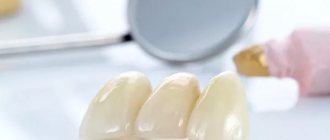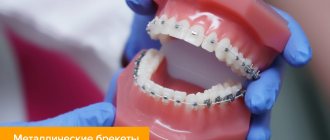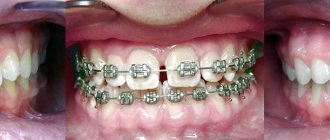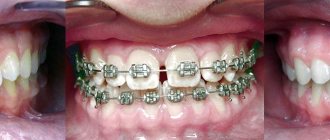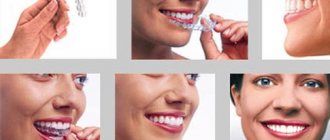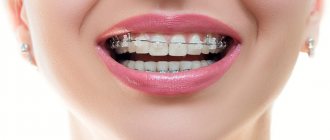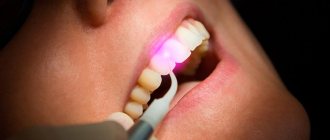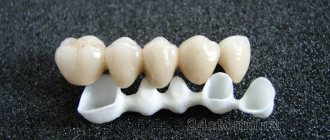Correction of the bite and alignment of the dentition is required not only for aesthetic improvement, but also to ease the load on the human chewing and speech systems, which may be impaired. Fixed orthodontic braces are used to straighten your smile. But treatment consists not only of fixing the structure, but also of timely care - cleansing, good nutrition, giving up bad habits. Dentiki specialists will tell you how to properly care for your teeth after installing braces using various devices.
General concepts
Regardless of the patient’s age, he will have to take a fresh look at oral hygiene, make the procedure more thorough, and also take care of its regularity. Classic cleaning in the morning and evening will not be enough; in addition, you need to get rid of food particles after each feast and even a small snack. At a minimum, rinsing is suitable for this.
You should be prepared for the fact that after installing braces, you will need to completely update your teeth cleaning tools.
You will need to buy a set of special brushes, an irrigator, dental floss, and also select toothpastes. Cleaning products for braces differ from regular ones in their contents:
- Enhanced cleansing.
- Additional disinfecting antibacterial effect.
- Corrosion protection (the system has metal elements).
- The inclusion of fluoride and calcium in the composition protects and strengthens the enamel where the brackets touch the teeth.
- Enzymes that help break down tiny food particles.
- The addition of bleaching granules may lead to an undesirable effect after the structure is removed. The enamel underneath will be more yellow than the other bleached areas.
In addition to selecting cleaning products, general recommendations include increased attention to food choices, as well as close monitoring of the cleansing procedure itself, and regular visits to your orthodontist and regular dentist.
Hygiene while wearing
Even if you are just about to install braces, it will be useful to learn some less familiar cleaning methods:
- First, buy a set of orthodontic toothbrushes;
- Secondly, you will need a waterpik. This is a small device that is mounted on the bathroom wall and cleans the interdental spaces with a stream of water under pressure;
- Third, you will need superfloss. It removes food particles and plaque from between the teeth, where the toothbrush cannot reach;
- Fourth, buy a set of brushes; they can be used to clean areas where it is impossible to reach with a toothbrush or floss.
Types of bracket systems
All correction plates are distinguished depending on the material from which they are made, as well as depending on the degree of curvature of the dentition. Let's see what types there are and what are their distinctive features:
- Metal. They were the very first to be invented. Correctors are made from thin steel wire, which is coated with special, including anti-corrosion, compounds. The advantages of the devices are maximum efficiency, speed of treatment, as well as affordable cost. They are very comfortable for the patient and make it easy to adapt to wearing braces. The bracket is considered the most reliable for any mechanical damage or load. But there is one drawback - the metal structure is noticeable on the teeth when smiling or talking.
- Ceramic. They are also durable, help correct bite and crookedness well and quickly, they are not difficult to adapt to, but they are distinguished from the previous version by their appearance. The devices are noticeable upon closer inspection, but are not striking because they are made in white.
- Lingual. The most modern option is installed on the back surface of the dental plates and is completely invisible from the outside. It is somewhat more difficult for the patient to get used to it. The device usually lasts longer than a metal one because correction occurs more slowly. Usually it is installed when the violations are not very strong.
How long does braces treatment last?
The length of treatment with braces is determined by several factors:
- the severity of the dental anomaly;
- the age of the patient, which determines the rate of metabolic processes in his body;
- the type of braces chosen and the accuracy of their installation on the teeth;
- professionalism of an orthodontist.
Adults should prepare themselves for one and a half to two years of serious work. Although during the treatment process, a doctor who monitors and controls the process can shorten or extend the period of wearing braces.
Experts note that most often patients who initially had vague ideas about its duration and the features that they will encounter are disappointed and dissatisfied with the treatment process. In a month, braces can move teeth no more than 1 mm. Therefore, it is so important to understand the monthly dynamics of the orthodontic process and be patient, and not just tune in to a positive result - a favorable smile that significantly improves the quality of life.
Patients should take an interest not only in photos before and after braces , but also in intermediate images. Monthly photos reflect well the results of treatment, although the patient himself sometimes gets the impression that the position of the teeth does not change at all.
Adaptation to braces
The corrective design can be compared to a pair of shoes. No matter how comfortable they are, they need to be broken in. Accustomation lasts up to a week, however, some lingual varieties require a whole month. The patient will not feel significant pain. In the first few days you may feel:
- Pressure on the soft tissues of the oral cavity.
- Feeling of chafing on cheeks.
- Difficulty with articulation.
- Inconvenience when chewing food.
But such manifestations should not scare you, they are temporary and go away on their own. When wearing it, you should not change your habits and daily routine in any way; you need to live a normal life, communicate with loved ones and friends. Moreover, this is inevitable - until the straightening process occurs, it will not be possible to remove the staples. And the only thing patients can do is endure a little inconvenience.
If you feel that the mucous membranes of the oral cavity are severely damaged by friction, or your speech has been significantly affected, you can use a special protective wax. It is sold in pharmacy chains.
The aching nature of the pain intensifies when chewing food. If the patient has a low pain threshold and high sensitivity, mild analgesics may be needed. In case of severe irritation or inflammation of the mucous membranes, you can rinse your mouth with a solution of chamomile or calendula. After a week of getting used to it, you will not have any unpleasant sensations, but only a nice metallic “decoration” of your smile.
Unlike vestibular braces, the installation of lingual braces will require a longer adaptation period. You may need to endure the inconvenience for up to one month. They will mainly concentrate in the area of articulation. Oral speech will be slightly complicated and modified. But patience pays off in that such structures are practically invisible from the outside. And if you order them to be made according to individual measurements, then the discomfort in the first weeks is virtually completely absent.
If the patient has severe pain, stomatitis, wounds in the mouth, or a filling has fallen out, then you should definitely consult a doctor and not self-medicate.
What can be included in the menu
Nutrition while wearing braces should be carefully thought out. Below is a list of products that are allowed to be included in the diet:
- porridge;
- puree soups;
- canned fish;
- Cod liver;
- vegetable caviar;
- soft cutlets, meatballs;
- fruit and vegetable smoothies;
- milk-based cocktails;
- soup with meatballs or finely chopped meat;
- yogurt;
- jelly;
- cottage cheese;
- soft fruits.
Knowing what you can eat while wearing braces, you will be able to avoid many problems, and the system will last the entire prescribed period.
Cleaning specifics: how to care for ceramic or metal braces
To maintain the shine of your smile, you need careful care, strictly on schedule and without laziness. The first rule is that after every meal, even after a small snack, you will need to carry out cleansing procedures. And in the morning and evening, use all your enthusiasm and at least 10 minutes of time. To do this, expand your arsenal, supplement the standard set for oral hygiene with special tools: a brush with V-shaped bristles, an irrigator, dental floss, and brushes of different lengths.
Dentiki dentists will tell you everything about additional care products, based on the characteristics of your case. Practice suggests that ligature structures require more complex care than classic, non-ligature ones.
To make it even easier to get rid of pieces of food stuck in the cavities between the teeth and arches, you can use a irrigator. This is a device that delivers a directed stream of liquid under pressure to areas that require additional cleaning. The method is not mandatory and self-sufficient, it is auxiliary. To refill the device, you can fill it with ordinary water or purchased pharmacy solutions. Caution should be exercised when using the device by people whose gums are sensitive and often bleed. Choose a model with built-in water pressure control. All of them are divided into mobile and stationary. The advantage of portable ones is that you can take them with you on the road and use them anywhere.
Basic rules
First, let’s note the order in which daily activities should be carried out:
- dismantle removable structures, if any;
- use a classic brush to make circular movements over the surface of the teeth;
- Clean areas near the brackets most carefully;
- clean the spaces between teeth using dental floss;
- if necessary, use an irrigator;
- rinse your mouth with mouthwash.
On average, the procedure takes about 10 minutes. In this case, cleansing should be both external and internal.
The more often you rinse, the more effective the result will be, because even plain water can be a good way to remove stuck pieces of food.
Particular attention should be paid to the oral cavity in the first days after installation. If you treat the cleansing carelessly, you can displace the structure, which, in turn, will lead to disruptions during treatment.
Get professional cleanings every year and see your orthodontist monthly. Such a set of procedures for caring for ceramic or metal braces should lead to the achievement of maximum effect.
Special brushes
We recommend avoiding ultrasonic hygiene devices, as they can negatively affect the fastening of structures. Use specialized tools of one of three types:
- Electrical. They are easy to use and require faster cleaning, but they give good results only when combined with ordinary and narrow brushes.
- Mono-beam. Bunches of bristles come in different lengths and directions. This ensures good contact with cavities, interdental spaces and other hard-to-reach elements.
- Orthodontic, also known as V-shaped. They have a recess in the middle for braces.
When using any of the above types, follow the rules:
- Apply toothpaste to a dry brush;
- When cleaning, always keep the handle in an inclined, fixed position;
- movements - circular;
- Don't avoid the rinsing step.
The brushes are included in the kit for caring for teeth with braces.
Externally, this brush has an elongated handle and a removable elongated head. This device is very effective for hard to reach places. Removing tiny food particles helps prevent tooth decay and other diseases.
On sale you can find brushes with several interchangeable nozzles of different lengths. The longer ones are for the front incisors, and the shorter ones are for the back molars. In addition, they may vary in the stiffness of the bristles. Dentiki doctors recommend replacing tips after two weeks of use.
When moving, you should be careful when pressing so as not to injure the gums.
Other devices
We include two auxiliary tools in this category:
- Irrigator. It delivers a thin stream of water or solution under pressure, which “knocks out” food particles.
- Flosses. This is a convenient device for using dental floss. The best thread is fluorine-containing, waxed. This strengthens the enamel and prevents the appearance of caries.
Food during the first days of installation
Installing braces requires following a strict diet. In the first days after its installation, the body adapts, during which a person most often experiences discomfort and pain caused by pressure on the teeth and gums. In this regard, the patient may have the feeling that the teeth are loose while eating. This may last 2-3 days.
Eating rough food becomes impossible. The most difficult adaptation period is observed in those who wear systems on both jaws.
The diet in the first days after installation includes foods only with a liquid or soft consistency:
- bouillon;
- cream soup;
- yogurt;
- smoothie;
- milk-based cocktail;
- gruel;
- curd;
- jelly;
- juice;
- fruit drink, etc.
Doctors recommend consuming baby food during this period, as it contains many vitamins and nutrients. The product saturates the body with all useful microelements, and its consistency is not capable of injuring the gums or causing damage to the structure.
In addition, the period after tightening the ligatures or replacing the arches is considered an adaptation period. During it, you also need to eat only liquid and semi-liquid food.
Nutrition with braces should also be based on your own feelings. If a particular food causes discomfort when consumed, then it is better to refuse it.
Nutritional Features
Patients have to adhere to a certain diet. This does not mean that you will have to eat less or only low-calorie foods. Restrictions will apply to hard and viscous products and drinks that contain a lot of dyes.
You should also be careful with very hot or extremely cold foods. Do not drink ice cream with coffee - temperature changes will lead to loss of elasticity of the structure.
Try to make your diet balanced. This is a good prevention of bacterial infection in the oral cavity. In addition, eat foods rich in protein and microelements (especially calcium, fluoride) to preserve enamel - eggs, fish and seafood, dairy products, fruits and vegetables.
There are several recommendations regarding food intake:
- Use a knife. Any dish that allows this should be cut into pieces, only then placed in the mouth. Avoid chewing large pieces for a long time. Distribute the load evenly.
- Don't bite apples, cucumbers, or any other fruits or vegetables with your front teeth. When eating them, also use cutlery.
- Try to eat at home or in an environment where you can rinse your mouth and use dental floss. Do not neglect this rule after every meal.
Eliminate hard foods
This is meat, apples and other fruits, vegetables with strong skins, and nuts fried over a fire. Despite the fact that the design of braces is quite strong, excessively hard food can cause harm to it.
The most reliable systems, in terms of susceptibility to mechanical damage, are metal, classic ones. Plastic, ceramic or sapphire are considered more fragile. Therefore, you should handle them carefully.
Avoid sticky foods
You will need to remove from your diet not only hard foods, but also those that have a viscous consistency, for example, caramel, candies such as toffee. They get very stuck in the spaces between the teeth and arches and are then difficult to clean out.
Don't use dyes
The last restriction on the menu concerns products with bright coloring properties. They should be abandoned, especially if the patient wears a plastic structure. This includes tea and coffee, beets, various sodas, and red wine. We also include cigarettes in this category. While wearing braces, you should give up this bad habit.
What not to do with braces
When wearing braces on your teeth, you will have to get rid of some bad habits, which include:
- chewing the tip of a pen or pencil;
- nail biting;
- drinking alcohol, etc.
When installing a system, many people wonder why they should not drink alcohol. The reason for this is their high content of sugars and other substances that have a bad effect on the enamel, forming a hard coating on it. When they settle on its surface, they cause caries and discoloration of the enamel. In addition, particles deposited on the structure can lead to gradual deformation and a change in its shade.
Alcoholic drinks are also dangerous because they dry out the oral cavity, making it vulnerable to various negative factors. Thus, structural elements can injure the gums, enamel and oral mucosa.
Features of installing braces in adults, adolescents and children
Installing braces for a teenager is not much different from installing braces for an adult.
Correcting the bite in children simply happens faster. The need for treatment with braces and the appropriate age will be determined by the orthodontist. For a teenager, the cost of braces in Moscow depends on the clinic and the chosen design. Braces are not used on baby teeth. If they are placed too early, the child may be left without teeth. To install braces, you will have to wait at least 10 to 12 years until your teeth change. The age after 14 years is optimal for using braces. Treatment occurs faster than in adults and is easier to tolerate.
Parents often doubt whether teenagers should get braces. Crooked teeth can lead to health problems over time. Incorrect positioning of teeth provokes the development of caries, periodontitis, and digestive problems.
How to install braces inexpensively?
Of course, everyone wants to have beautiful, straight teeth. But in the pursuit of the perfect smile, not the least important question is where the installation of braces in Moscow is inexpensive. The compulsory medical insurance policy does not include bite correction and teeth straightening, which means you have to pay for them. Orphans, disabled children, and children with congenital jaw pathologies have the right to preferential treatment. Free installation of braces in the clinic is provided for patients injured due to medical errors.
You can use tricks and look for great deals at dental clinics. Often, braces are offered as a gift during orthodontic treatment. There are also gifts from trial batches of new products. Many clinics actively use savings systems. The bonuses accumulated over the year may well be enough to pay for braces. The most profitable offers are in the turnkey format.
It is immediately clear how much you will have to spend, and in the future - to avoid mark-ups.
However, be prepared for serious financial costs. Orthodontic treatment is not quick; it takes from 1 to 2.5 years to correct a bite. The most economical braces are metal, from 15,000 rubles. Ceramic models will cost more - from 35,000 rubles and sapphire - from 40,000 rubles. For invisible lingual braces you will have to pay significantly more than for vestibular models - from 100,000 rubles. All prices are for installing braces on one jaw.
.
Why do braces cause irritation?
Modern metal and ceramic braces are small in size and have rounded edges. Although manufacturers try to make the design as comfortable as possible for patients, you need to get used to it, like any foreign body. But during the period of adaptation, irritation and inflammation may appear on the mucous membrane.
- The irritation may be an allergic reaction to the metal. In this case, treatment will most likely be suspended to replace the metal bracket system with a ceramic one. In order to avoid miscalculations, it is necessary to inform the orthodontist about your tendency to allergies even at the stage of choosing braces and, possibly, undergo additional examination at an allergy center.
- An orthodontic arch that is too long may be installed. By bending it, the dentist may not completely “twist” the sharp edge, which will scratch the mucous membrane and provoke the appearance of wounds.
- Quite often, the braces themselves, attached to the teeth, come off. The detached edge can also injure the mucous membrane, but on the inner surface of the lips.
All these problems can be solved with timely consultation with your doctor. The bracket will be glued, and the overly long edge of the arch will be trimmed and bent correctly. Rinsing with herbal decoctions will help quickly soothe irritated mucous membranes. A little more effort will be required if even after this the braces still rub the cheek mucosa.
